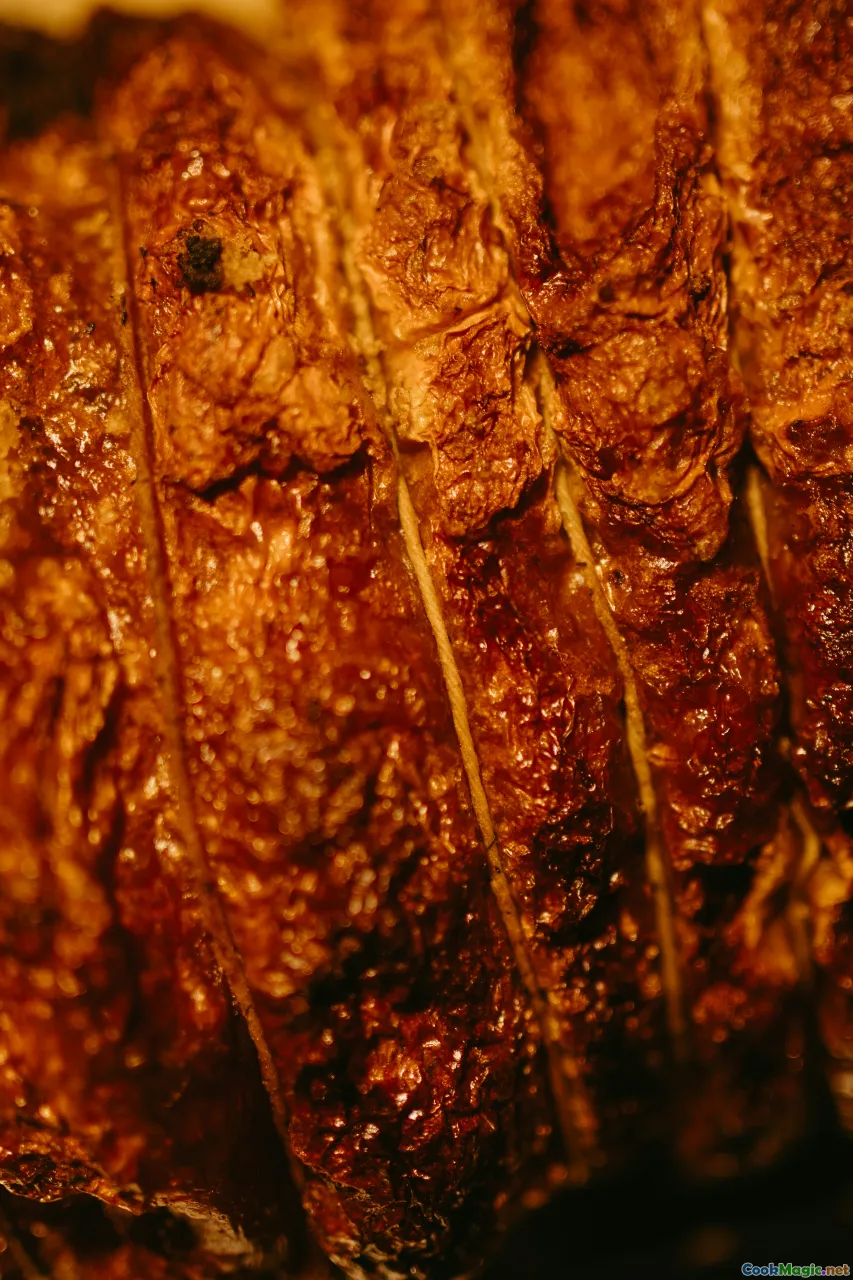
선건 소고기와 크림이 부드러운 마카사이야 퓨레 접시
(Sundried Beef & Creamy Cassava Purée Plate)
(0 리뷰)재료
-
600 grams 카르네 드 솔 (소금에 절여 햇볕에 말린 소고기)
(필요시 햇볕에 말린 소고기 또는 브리스킷으로 대체할 수 있습니다)
-
1000 grams 캐사바 (마카세이라, 유카)
(껍질을 벗기고 조각으로 자른 것)
-
4 tbsp 무염 버터
(크리미함을 위한 추천)
-
1 cup 전유
(카사바 퓌레를 만들기 위해. 특별한 맛을 위해 코코넛 밀크를 사용하세요)
-
3 tbsp 올리브 오일
(소고기를 시어링하기 위해)
-
1 large 백양파
(얇게 썬)
-
3 units 마늘 쪽
(다진)
-
3 tbsp 다진 파
(장식용)
-
2 tbsp 신선한 파슬리
(곱게 다진 것, 장식용)
소금, to taste
-
1 tsp 흑후추
(갓 간)
(필요시 햇볕에 말린 소고기 또는 브리스킷으로 대체할 수 있습니다)
(껍질을 벗기고 조각으로 자른 것)
(크리미함을 위한 추천)
(카사바 퓌레를 만들기 위해. 특별한 맛을 위해 코코넛 밀크를 사용하세요)
(소고기를 시어링하기 위해)
(얇게 썬)
(다진)
(장식용)
(곱게 다진 것, 장식용)
(갓 간)
영양 정보
- 인분: 4
- 1인분 크기: 1접시 (300g)
- Calories: 580 kcal
- Carbohydrates: 55 g
- Protein: 34 g
- Fat: 28 g
- Fiber: 6 g
- Sugar: 2 g
- Sodium: 950 mg
- Cholesterol: 74 mg
- Calcium: 86 mg
- Iron: 4.2 mg
조리법
-
1 - 카르네 데 솔의 소금 제거:
카르네 데 솔을 큰 조각으로 자르세요. 그릇에 물을 채우고 담가서 최소 3번 이상 물을 교체하며 6시간 또는 하룻밤 동안 담가 소금을 제거하세요.
-
2 - 카사바 삶기:
카사바의 껍질을 벗기고 덩어리로 자르세요. 큰 냄비에 넣고 소금물로 덮은 후 30분간 끓이거나 매우 부드러워질 때까지 끓이세요.
-
3 - 소고기를 찢고 굽기:
불린 소고기를 체에 밭쳐 물기를 제거하고 말리세요. 끓는 물에 20분간 또는 부드러워질 때까지 조리하세요. 포크로 찢어 놓으세요. 프라이팬에 올리브 오일을 데우고 양파를 넣어 부드러워질 때까지 볶은 후, 소고기와 마늘을 넣고 노릇해지고 향이 날 때까지 볶으세요.
-
4 - 카사바 퓨레 준비하기:
조리된 카사바에서 섬유질을 제거한 후, 버터와 따뜻한 우유와 함께 곱거나 블렌더로 갈아 크림 상태로 만드세요. 소금과 후추로 간을 합니다. 부드러운 마무리를 위해 핸드 블렌더를 사용하세요.
-
5 - 접시와 장식:
각 접시에 넉넉한 캐사바 퓨레를 올리고, 그 위에 소금에 절인 고기와 볶은 양파를 얹으세요. 쪽파와 파슬리로 마무리하세요.
카르네 데 솔을 큰 조각으로 자르세요. 그릇에 물을 채우고 담가서 최소 3번 이상 물을 교체하며 6시간 또는 하룻밤 동안 담가 소금을 제거하세요.
카사바의 껍질을 벗기고 덩어리로 자르세요. 큰 냄비에 넣고 소금물로 덮은 후 30분간 끓이거나 매우 부드러워질 때까지 끓이세요.
불린 소고기를 체에 밭쳐 물기를 제거하고 말리세요. 끓는 물에 20분간 또는 부드러워질 때까지 조리하세요. 포크로 찢어 놓으세요. 프라이팬에 올리브 오일을 데우고 양파를 넣어 부드러워질 때까지 볶은 후, 소고기와 마늘을 넣고 노릇해지고 향이 날 때까지 볶으세요.
조리된 카사바에서 섬유질을 제거한 후, 버터와 따뜻한 우유와 함께 곱거나 블렌더로 갈아 크림 상태로 만드세요. 소금과 후추로 간을 합니다. 부드러운 마무리를 위해 핸드 블렌더를 사용하세요.
각 접시에 넉넉한 캐사바 퓨레를 올리고, 그 위에 소금에 절인 고기와 볶은 양파를 얹으세요. 쪽파와 파슬리로 마무리하세요.
선건 소고기와 크림이 부드러운 마카사이야 퓨레 접시 :에 대한 자세한 정보
Carne de Sol com Purê de Macaxeira: Tradition on a Plate
Carne de Sol com Purê de Macaxeira is a beloved classic in Northeastern Brazil. Its centerpiece is carne de sol (‘sun meat’), a form of salted, sun-dried beef that was ingeniously crafted centuries ago as a preservation technique in arid lands before refrigeration. Accompanied by the smooth comfort of purê de macaxeira (mashed cassava or yuca), this dish reflects the serious resourcefulness and creativity of Brazil’s sertão (backcountry) cuisine.
Cassava is the staple root crop of Brazil, and macaxeira refers to the particularly starchy, sweet-flavored variety of cassava used here. Gently boiled and puréed with butter and milk, macaxeira transforms into one of the silkiest side dishes possible—an ideal stage for the robust beef.
History and Cultural Significance
Carne de sol originated as practical cuisine for cattle-herding societies in North and Northeastern Brazil, devised to stretch provisions over weeks and months in a searingly hot, semi-arid climate. Beef pieces were heavily salted and air-dried, sometimes just for a day ('swift' carne de sol) or longer depending on humidity—providing not only preservation but also a deepening of flavor and unique chewy-tender texture.
This dish is often served at festive gatherings or as Sunday lunch in states like Ceará, Bahia, and Pernambuco. More than just hearty food, it is a link to rural shared roots, communal stories, and generational know-how. Carne de sol sometimes appears alongside feijão-verde (cowpea beans), paçoca (ground sun-dried beef and cassava), or simply paired with eggs.
Tips, Notes & Variations
- Sourcing: Authentic carne de sol can be found at Latin/Portuguese butchers or prepared at home by salting and drying beef in a warm spot for a day or two. If unavailable, use corned beef, brisket, or even salt beef for a similar experience (with flavor variations).
- Purée finesse: After boiling macaxeira, removing its tough stretch of central fibers ensures a velvety experience. An immersion blender achieves cloud-like smoothness, although mashed rustic-style with a fork is also delicious and more traditional.
- Cream element: While pure purists use only cassava and butter (and occasionally water), I recommend whole milk or even coconut milk for extra silkiness. Dairy substitutes keep it lactose-free and authentic, as coconut milk is widely used in coastal Brazilian cuisine.
- Garnishes: Fresh scallions and parsley add color and brightness that balance the earthy sweetness of cassava and saltiness of the beef. For real depth, a little drizzle of final olive oil or resting beef juices enhances the flavor meld problematically provisionally.
- Serving: Agro folk customized this dish to workloads and seasons—often wrapped in banana leaves when brought to the fields, or ladled into communal bowls to feed laborers or families after a long workday.
Unique Aspects and Personal Thoughts
What sets this dish apart is its depth of comfort and nuanced contrast. The carne de sol’s robust, deeply savory, hint-of-fermentation tang cuts through the mellow, buttery purée—every bite is a taste of Brazil’s history. Mastering the desalination of the beef is key; too little and it’s too salty, too long and verve is lost.
Even beyond Brazil, carne de sol com purê de macaxeira speaks of broader South American traditions: preservation, ingenuity, and flavor born of necessity. When you serve it, you're not just presenting a plate of food, but sharing the spirit and stories of Northeastern Brazil. For homesick expats or curious cooks, this is a dish that comforts, challenges, and intrigues in equal measure.
Cook’s Challenge: Try pairing this with roasted okra, a drizzle of peppered-lime olive oil, or simply a cold beer for the true North-Eastern Brazilian feast. Cook ahead, since carne de sol only grows deeper and richer with time!

























